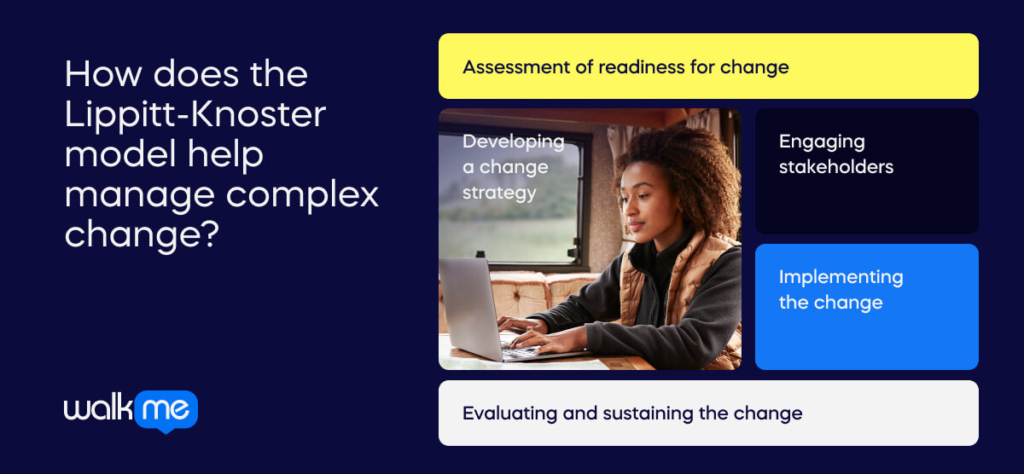Change management can be daunting, especially when it involves systems and multiple stakeholders.
It requires careful planning, effective communication, and a deep understanding of the organization’s culture and dynamics. However, with the right framework and approach, managing complex change can become more manageable and even successful.
One such framework is the Lippitt-Knoster model.
The Lippitt-Knoster model is a comprehensive and structured approach to managing complex change. It was developed by R. Lippitt and T. Knoster in the 1980s and has since been used widely in various sectors, including healthcare, education, and business.
The model consists of seven stages that guide managers through the entire change process, from diagnosing the need for change to sustaining the change over time.
One thing that a lot of businesses fail to realize is that change often requires more than just a one-time effort. The Lippitt-Knoster model is designed to help managers build and maintain a continuous process that leads to successful change.
This article will look at the Lippitt-Knoster model in detail and how it can help managers successfully manage complex change.
What Is Complex Change?
A complex change management project occurs when one or more complicating factors create an obstacle. They can include:
- Geographically diverse locations
- Low investment from employees
- Major organizational restructuring
- Involuntary redundancies or job losses
- Crisis management
- Change saturation
Some of these problems may be present in simpler forms in any change management project. For example, long-standing staff members are often resistant to organizational change.
However, when all employees are apathetic, disengaged, and resistant to the proposed change, the difficulty of the organizational change increases dramatically.
Why Is Managing complex change Important?
The future of any business depends on managing complex change effectively. Of course, any change management project involves risks. Staff, revenue, and customer relations can all negatively affect a poorly organized change management scheme.
In situations of complex change, every part of the change strategy becomes far more challenging. A recent Gartner report suggests that it’s difficult to maintain self-control, transparent decision-making, and teamwork when managers face paradoxes and uncertainty.
When managers struggle with the complexity of the situation around them, it will be even harder to maintain positive attitudes from across a team. Pre-existing models to manage complex change can bring the best out of everyone and negate organizational conflict.
What is the Lippitt-Knoster model?

The Lippitt-Knoster change management model identifies the elements required for effective change: vision, consensus, skills, incentives, resources, and an action plan.
The model was created by Mary Lippitt and Timothy Knoster and is used as a tool for planning and diagnosing issues when managing complex change. Some sources also refer to it as the “Model for Managing Complex Change.”
Lippit-Knoster model key steps:
- Vision – Clear and compelling vision is critical to successful change management. Leaders must establish a shared understanding of the desired outcome and communicate it effectively to all stakeholders.
- Skills – The Lippitt-Knoster model emphasizes assessing whether individuals and teams have the necessary skills and competencies to support the change. If not, leaders must provide training and development opportunities.
- Incentives – Change can be difficult, so providing incentives to motivate and reward individuals and teams for their efforts is important. Incentives can take many forms, such as recognition, promotions, or financial rewards.
- Resources – Leaders must ensure that sufficient resources, such as time, money, or technology, are available to support the change effort. Without adequate resources, the change initiative is likely to fail.
- Action Plan – Finally, leaders must create a detailed action plan that outlines the steps required to achieve the vision. The action plan should be specific, measurable, achievable, relevant, and time-bound (SMART) and communicated effectively to all stakeholders.
How does the Lippitt-Knoster model help manage complex change?

In order to understand how the Lippitt-Knoster model helps manage complex change, it is important to first understand what makes a change initiative “complex.”
Complex change involves multiple stakeholders, high uncertainty, and a need for coordinated action.
The Lippitt-Knoster model can help to manage complex change by providing a comprehensive and structured approach that guides managers through the entire process. Here are five ways the Lippitt-Knoster model can help manage complex change
Assessment of readiness for change
The Lippitt-Knoster model emphasizes the importance of assessing an organization’s readiness for change before initiating any transformation efforts. This involves evaluating the organization’s current state, identifying potential challenges, and determining whether the organization has the necessary resources and capabilities to implement the changes.
Developing a change strategy
Once the assessment is complete, developing a comprehensive change strategy is next. This involves setting clear goals and objectives, identifying potential risks and challenges, and outlining specific actions that need to be taken to achieve the desired outcomes.
Engaging stakeholders
The success of any change initiative depends on the support and buy-in of key stakeholders. The Lippitt-Knoster model emphasizes the importance of engaging stakeholders throughout the change process, from the initial planning stages to the final implementation and evaluation.
Implementing the change
The Lippitt-Knoster model emphasizes the importance of careful planning and execution when implementing changes. This involves establishing a clear timeline, allocating resources, and ensuring that everyone involved in the change is properly trained and informed.
Evaluating and sustaining the change
Finally, the Lippitt-Knoster model emphasizes the importance of ongoing evaluation and monitoring to ensure the change is sustainable over the long term. This involves collecting data, measuring progress against goals, and making adjustments as necessary to ensure that the change continues to deliver the desired results.
The managing complex change matrix
The Managing Complex Change Matrix provides a framework for managing these changes effectively. It was developed by Dr. Dean Anderson and Dr. Linda Ackerman Anderson, who are renowned experts in the field of organizational change.
Overview of the Managing Complex Change Matrix

The Managing Complex Change Matrix consists of four quadrants that represent different change management strategies:
- Clearing a Path: This quadrant involves assessing the organization’s current state and identifying any obstacles hindering the change process. Once identified, these obstacles are removed or addressed to create a clear path for change.
- Building Momentum: This quadrant involves building support for the change among stakeholders and developing a plan for implementing the change. The focus is creating a sense of urgency and excitement around the change.
- Engaging People and Culture: This quadrant involves engaging employees and other stakeholders in the change process. The focus is building relationships, fostering collaboration, and addressing resistance to change.
- Making it Stick: This quadrant involves sustaining the change over time and integrating it into the culture of the organization. The focus is embedding the change into the organization’s processes and systems to ensure long-term success.
Key Elements of the Managing Complex Change Matrix

There are several key elements of the Managing Complex Change Matrix that contribute to its effectiveness:
- Systemic Thinking: The matrix takes a holistic approach to change management by considering the entire organization as a system. This helps to identify potential roadblocks and dependencies that must be addressed for the change to be successful.
- Iterative Process: The matrix is not a linear process but rather an iterative one. This means that each quadrant may need to be revisited multiple times throughout the change process to ensure that the change is progressing effectively.
- Leadership: The matrix emphasizes the importance of leadership throughout the change process. Leaders must provide direction, communicate effectively, and build trust to ensure successful change.
- Culture: The matrix recognizes the critical role that organizational culture plays in change management. Culture can either enable or hinder change, so it must be addressed throughout the change process.
Benefits of the Managing Complex Change Matrix

The Managing Complex Change Matrix provides several benefits for organizations undergoing change:
- Clarity: The matrix provides a clear framework for managing change, which can help to reduce confusion and uncertainty among stakeholders.
- Flexibility: The iterative nature of the matrix allows organizations to adapt to changing circumstances and adjust their approach as needed.
- Holistic Approach: The matrix considers the entire organization as a system, which helps to identify potential roadblocks and dependencies that may impact the success of the change.
- Employee Engagement: The matrix emphasizes the importance of engaging employees and other stakeholders in the change process, which can help to build support and enthusiasm for the change.
The Lippitt-Knoster model explained
It’s useful for businesses to understand Lippit-Knoster’s various stages in detail. Managing complex change requires an understanding of the stages that people go through when they are faced with a major change.
Here’s an in-depth explanation of each stage in the Lippitt-Knoster model:
Diagnosis
The first stage of the Lippitt-Knoster model involves identifying the need for change within an organization. This can be done through data analysis, surveys, and focus groups. This stage aims to understand the organization’s current state and identify areas that require improvement. The diagnosis stage involves collecting information about the problem, its scope, and its impact on the organization.
During the diagnosis stage, involving all stakeholders affected by the change is essential. This includes employees, managers, and other key personnel. By involving all stakeholders at this stage, the organization can ensure that everyone understands the need for change and is invested in the outcome.
Assessment
Once the need for change has been identified, the next stage involves assessing the organization’s readiness for change. This includes evaluating the resources and capabilities of the organization, as well as the willingness of employees to embrace change. This stage aims to determine whether the organization has the necessary resources and support to implement the changes successfully.
To assess the organization’s readiness for change, it is important to consider factors such as the company culture, employee morale, and the organization’s history with change initiatives. This stage requires careful evaluation and analysis to ensure that the change process is set up for success.
Planning
In the planning stage, a change strategy is developed based on the findings from the diagnosis and assessment stages. This involves creating a detailed plan outlining the steps required to implement the change and the resources needed to support the change process. The plan should include clear objectives, timelines, and responsibilities for all stakeholders involved in the change process.
During the planning stage, it is important to consider potential roadblocks and develop contingency plans to address them. A successful change strategy should also include regular communication with stakeholders to keep them informed and engaged throughout the process.
Implementation
The implementation stage is where the actual change takes place. This involves communicating the change to all stakeholders, providing employee training and support, and establishing new processes and systems to support the change. Ensuring all stakeholders know the changes and fully understand their roles is important.
Close monitoring is required to ensure the changes are implemented effectively during the implementation stage. This may involve collecting stakeholder feedback, measuring progress against objectives, and adjusting as needed.
Evaluation
The final stage of the Lippitt-Knoster model involves evaluating the success of the change process. This includes measuring the impact of the change on the organization and determining whether the desired outcomes have been achieved. Based on the evaluation, adjustments may be made to the change strategy to ensure continued success.
The evaluation stage is also an opportunity to celebrate successes and recognize the contributions of all stakeholders involved in the change process. The organization can use this information to guide future change initiatives by documenting the results and analyzing the feedback.
Managing complex change with the Lippit-Knoster model: Is it right for you?
Managing complex change is a challenging task that requires a well-planned strategy to achieve success.
The Lippit-Knoster model has proven to be an effective framework for managing complex changes by breaking down the process into manageable steps. This model provides a structured approach to help organizations navigate change management challenges and achieve their desired outcomes.
However, it is important to note that the Lippit-Knoster model may not be suitable for all situations. Before deciding to use this model, organizations should carefully consider their unique needs and circumstances. They should also assess whether they have the necessary resources for the changes, including skilled staff and budget. If you find that the Lippit-Knoster model is not right for you, we’ve identified three other change management models you can use to lead a fast-evolving digital workplace.
Common Questions
By pacing initiatives, aligning them with strategic priorities, and providing adequate support, organizations can mitigate change fatigue and maintain employee engagement.
Achieving stakeholder consensus ensures alignment, reduces resistance, and facilitates smoother implementation of change initiatives, leading to more sustainable outcomes.
Organizations should reassess their change management strategies when facing persistent resistance, declining performance metrics, or after significant organizational shifts to ensure continued effectiveness.
Omitting any critical element—such as vision, skills, incentives, resources, or an action plan—can lead to confusion, resistance, or failure in the change process.

